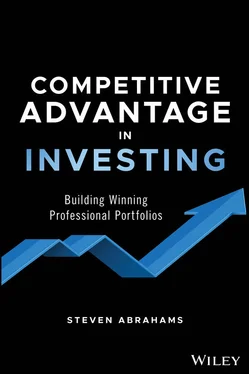Significant elements of investment performance seem to rely on things beyond CAPM's simple multiple of excess market performance. CAPM again falls short.
At the same time that both theorists and practitioners embraced CAPM and began to see its shortcomings, intriguing explanations and steps in new directions began to emerge.
Both the flatness of returns relative to Sharpe's CAPM predictions and the influence on returns of factors beyond beta have led other analysts to argue that structural aspects of markets—not addressed by CAPM—lead to these results. In fact, Fischer Black, who spent years immersed in theory at the University of Chicago and years immersed in markets at Goldman Sachs, notes this possibility (Black, 1993):
Another reason for a flatter line is restricted borrowing. Margin requirements, borrowing rates that are higher than lending rates, and limited deductibility of interest costs all tend to make the line flatter. Those who can't borrow at good rates bid up the prices of high-beta stocks instead.
Yet another reason for a flatter line, I believe, is investor psychology, in particular “reluctance to borrow,” even when the rules allow it and the rates are good. Many people seem to dislike the idea of borrowing or the trading needed to adjust borrowing amounts to the values of their securities portfolios. (p. 38)
Andrea Frazzini and Lasse Pedersen also argue that limits to investors' ability to leverage or deleverage positions in the market basket explain some of the flatness in realized returns (Frazzini and Pedersen, 2012):
For instance, individual investors and pension funds may not be able to use any leverage, banks face regulatory capital constraints, and hedge funds must satisfy their margin requirements. However, an investor can gain substantial market exposure without using outright leverage by buying options, leveraged ETFs, or other securities that embed the leverage. In fact, many of these securities are designed precisely to provide embedded leverage. (p. 1)
Because of these limits to leverage, Frazzini and Pedersen echo Black's assumption that investors pay a premium to buy assets with embedded leverage. That leverage can come from a high beta to an underlying index or assets. They show that a series of assets with high betas, such as short-dated, out-of-the-money options on single equities or equity indices, produce consistently lower returns than similar assets with low betas, such as long-dated, in-the-money options on single equities or equity indices. They find the same result when comparing exchange-traded funds without embedded leverage, such as a simple exchange-traded fund that might track the S&P 500, against a fund that tracks some multiple of the daily return on the same S&P 500. Adjusted for exposure to the referenced asset, the leveraged fund produces consistently lower returns. Limits to leverage may be only one limit that explains the shortfall of CAPM.
Cliff Asness and Tobias Moskowitz have joined Lasse Pedersen, all affiliated at some point in their careers with the University of Chicago and the asset manager AQR, to extend the search for factors that influence value on a wide range of assets (Asness, Moskowitz, and Pedersen, 2013). They find evidence for a value factor, such as book-to-market for equities and similar measures for other assets, and evidence for a momentum factor, linking recent and future performance. And they find evidence for value and momentum in a wide range of settings: in the US, UK, European, and Japanese equity markets; in equity index futures, government bonds, currencies, and commodity futures. The search across markets enables Asness and his colleagues to look at the correlations among these strategies in otherwise unrelated markets, and they find returns on value strategies positively correlated with value strategies across markets, momentum strategies similarly correlated across markets, and value and momentum negatively correlated within and across markets. That raises the issue of a potential common cause. They find modest links to macroeconomic variables such as business cycle, consumption, and default. They find more evidence of a common link through liquidity, particularly the availability and cost of funding, although it only explains a small part of the return premium.
The work that finds factors other than beta that help explain asset performance draws criticism from theorists who argue that the factors only represent ad hoc ways to capture historical patterns of return, and that the factors do not represent separate, systemic, and undiversifiable sources of risk. But Fama and French (2004) argue that additional factors still challenge CAPM if they are well diversified and capture aspects of performance that the market portfolio alone misses. This is less of a concern for practitioners.
Theorists also argue that CAPM has not been properly tested and maybe never will because no one has looked at performance against a complete portfolio of market assets. That complete portfolio might not include just traded equity and debt; it might also include real estate, insurance, earnings, and other things that accrue from human capital. The factors highlighted by Fama and French and Jegadeesh and Titman might simply be measuring the extra return from these excluded factors. Including these factors might properly steepen the line between beta and returns. But because analysts cannot easily measure and include these factors, this could be a permanent but unresolvable objection to tests of CAPM.
Of more concern for practitioners is the potential errors made by applying a Sharpe-Linter or Black CAPM. Practitioners estimating a fair value of equity stand to get it wrong, at least by more elaborate factor models, for companies at the extremes of book-to-market or small-to-large. And investors trying to evaluate investment managers might attribute too much portfolio return to manager skill in portfolios stocked with low book-to-market or small equities.
CAPM remains, as Fama and French acknowledge, “a theoretical tour de force” (Fama and French, 2004). If CAPM consistently misses important features of asset returns, however, then the hunt starts either for better tests of the theory or for better theories. It is in the latter direction that we go next.
4 Toward a New Capital Asset Pricing Model
A New Focus on Leverage
The work of Harry Markowitz highlights the trade-off between risk and reward and the power of diversification. Sharpe and others then argue heroically that all investors should hold some combination of cash and a market portfolio. Markowitz's emphasis on risk and reward and diversification remains as powerful and practical today as it did when he first published his seminal paper. Sharpe's CAPM, however, although offering an appealing elegance, has proven a poor explanation of investment returns in practice. Asset prices clearly depend on more than broad exposure to market risk. And the very work that tested CAPM ends up planting the seeds of a more nuanced approach.
The richest grounds for new thinking come from work that focuses on the ability of investors to use the leverage at the center of CAPM. CAPM assumes investors can borrow without limit at the riskless rate and leverage the market portfolio into expected returns well above an unleveraged portfolio of risky assets ( figure 4.1), but if borrowing is limited, investor behavior changes. And so does asset pricing.
A complete inability to borrow at the riskless rate has long had potential to explain the flat capital markets line. Fischer Black and his colleagues started making that case in the 1970s (Black, 1972; Black, Jensen, and Scholes, 1972). Borrowers may not be able to borrow at the riskless rate, but they may be able to sell assets short. That usually involves borrowing a security from another owner, selling the security to generate cash, and then buying the security back later and returning it to the original owner. If borrowers can sell assets short and use the cash proceeds to leverage a portfolio, then Black shows the capital markets line will look flatter than CAPM predicts. A complete lack of borrowing, however, is unrealistic. Some banks, some insurers, and portfolios affiliated with government agencies, for instance, routinely borrow at nearly riskless rates. A wide set of other portfolios take out loans secured by nearly riskless debt and can borrow substantial amounts at nearly riskless rates. Portfolios that hold US Treasury debt, for example, can borrow $0.98 for every $1 of market value. Riskless or nearly riskless borrowing is clearly available.
Читать дальше












